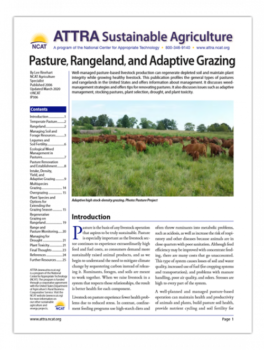Pasture, Rangeland, and Adaptive Grazing

Adaptive high stock-density grazing. Photo: Pasture Project
By Lee Rinehart, NCAT Agriculture Specialist
Abstract
Well-managed pasture-based livestock production can regenerate depleted soil and maintain plant integrity while growing healthy livestock. This publication profiles the general types of pastures and rangelands in the United States and offers information about management. It discusses weed-management strategies and offers tips for renovating pastures. It also discusses issues such as adaptive management, stocking pastures, plant selection, drought, and plant toxicity.
Contents
Introduction
Temperate Pasture
Rangeland
Managing Soil and Forage Resources
Legumes and Soil Fertility
Ecological Weed Management in Pastures
Pasture Renovation and Establishment
Intake, Density, Yield, and Adaptive Grazing
Multispecies Grazing
Overgrazing
Plant Species and Options for Extending the Grazing Season
Regenerative Grazing on Rangeland
Range and Pasture Monitoring
Managing for Drought
Plant Toxicity
Final Thoughts
References
Further Resources
Introduction
Pasture is the basis of any livestock operation that aspires to be truly sustainable. Pasture is especially important as the livestock sector continues to experience extraordinarily high feed and fuel costs, as consumers demand more sustainably raised animal products, and as we begin to understand the need to mitigate climate change by sequestering carbon instead of releasing it. Ruminants, forages, and soils are meant to work together. When we raise livestock in a system that respects those relationships, the result is better health for each component.
Livestock on pasture experience fewer health problems due to reduced stress. In contrast, confinement feeding programs use high-starch diets and often throw ruminants into metabolic problems, such as acidosis, as well as increase the risk of respiratory and other diseases because animals are in close quarters with poor sanitation. Although feed efficiency may be improved with concentrate feeding, there are many costs that go unaccounted. This type of system causes losses of soil and water quality, increased use of fuel (for cropping systems and transportation), and problems with manure handling, poor air quality, and odors. Stresses are high to every part of the system.
A well-planned and managed pasture-based operation can maintain health and productivity of animals and plants, build pasture soil health, provide nutrient cycling and soil fertility for subsequent crops, reduce input costs, and achieve a positive economic return, given a well-conceived marketing plan.
Much of the grazing land in the United States can be used more efficiently than it is at present. By using intensively managed grazing techniques, producers have historically stocked perennial grass pastures, such as those that occupy large sections in the Southern Great Plains, with double the number of cattle they normally would. This has positive effects on forage availability and efficiency of use. Allen Williams, a leading expert in regenerative, adaptive grazing, has noted that providing extended periods of rest between short, high stock-density grazing periods allows for optimum recovery of forages and increases overall forage dry matter production (Williams, no date). Even on the arid rangelands of the western United States, increased stock density, coupled with decreased time on a pasture and long rest periods, has been successful in improving condition (Park et al., 2017).
“Probably one of the most important things about living on this planet is the microbiotic community, our microbiome. We now know that there are millions of species of bacteria and half as many fungal species, of which we’ve identified less than 5%.
The same kind of things [sic] goes on in animals. We’re finding out that, for example, ruminants that forage or eat grass do not consume the nutrients that are in the forages; they ferment them in this rumen, this tank, where they’re growing tremendous numbers of microbes. Then they ingest these microbes.
We’re finding out that the actual ecology of the animal is predicated on what it’s fed. If you’re feeding an animal an abstract kind of feed like grain when it’s really a forage consumer, you’re going to end up changing the ecosystem of that rumen. You’re going to end up having a downward spiral of negative outcomes, where animals end up having all these metabolic disorders—immune implosion, reproductive failure, mastitis, calf deaths, mortality, and morbidity.”
– Jerry Brunetti, quoted in Mercola, 2013
The ecological processes that occur on temperate pastures and on arid rangelands are basically the same, but they occur much slower on rangelands, due mainly to temperature and moisture differences. The following section is an attempt to clarify the nature of both types of pasture ecology.
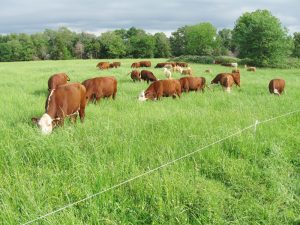
Temperate pasture in Arkansas. Photo: Jeremy Prater
Temperate Pasture
Temperate pastures are typically very productive. They are characterized by well-developed soils, medium to high precipitation, and moderate to rapid nutrient cycling. They can be dominated by warm-season or cool-season plants and occupy niches from Maine to Florida, from Texas to Minnesota, and from Southern California to the Pacific Northwest coastal regions of Washington and Oregon. Many irrigated riverine pastures in the Intermountain and Desert West also resemble temperate pastures due to deeper soils, adequate moisture from irrigation or high water tables, and the presence of high-yielding plant species such as bromegrass and alfalfa. Temperate pastures will on average yield anywhere from 2,000 pounds of dry matter per acre per year to well over 12,000 pounds per acre, depending on the species, soil type and fertility, growing season, grazing management, and other environmental factors, such as rainfall and soil water-holding capacity.
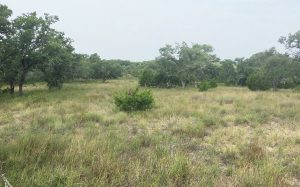
Rangeland in the Texas Hill Country. Photo: Lee Rinehart, NCAT
Rangeland
According to the Society for Range Management, rangelands are a type of land on which the natural vegetation is dominated by grasses, forbs, and shrubs, and the land is managed as a natural ecosystem (Society for Range Management, 1998). In North America, rangelands include the grasslands of the Great Plains stretching from Texas to Canada, from the prairie states of the Dakotas and Nebraska to the annual grasslands of California, and forestlands and wetlands throughout North America. This definition includes arid shrublands throughout the western United States, the arctic tundra and mountain meadows, and deserts throughout the Southwest. Rangeland can also encompass pastures of introduced dryland grasses, such as crested wheatgrass, that are managed as rangelands. Arid rangelands, which typify much of Arizona, New Mexico, Colorado, Utah, Nevada, Idaho, Montana, Wyoming, Oregon, California, and Washington, can yield anywhere from 200 to 4,000 pounds or more of dry matter per acre, depending on the soil type, elevation, and annual precipitation.
Rangelands are typically characterized by low precipitation, shallow soils, and slow nutrient cycling. They are dominated by plants efficient at water and nutrient utilization, so practices that are appropriate to temperate pastures, such as fertilization and plowing, are often inappropriate on rangelands. Regardless, rangelands can be very productive, providing sustainable income for ranch communities while protecting valuable natural resources through appropriate grazing strategies. Specific strategies for sustainable rangeland management are covered in the section, Regenerative Grazing on Rangeland, below.
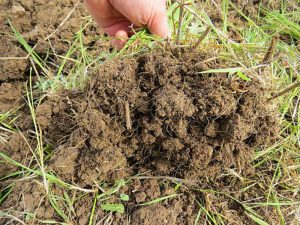
Well-aggregated soil has a crumb structure resembling cottage cheese. Photo: NCAT
Managing Soil and Forage Resources
Fertile soil is the foundation of sustainable livestock production. “Soil macro- and micro-organisms are the external digestive system that processes organic matter, delivering a smorgasbord of minerals, vitamins, and other nutrients to the crop at a metered pace. This is in contrast to the conventional approach where crops are flooded with a limited number of soluble fertilizer nutrients, leading to ‘luxury consumption,’ imbalanced plant nutrition, and a susceptibility to disease and attack by insect pests” (NCAT, 2004).
Soil is a living organism, in a sense, and the management practices we use have an impact on the health of the entire system. To regenerate unhealthy soil and maintain soils in peak health, farmers are minimizing tillage. This preserves soil structure, encourages aggregation, and keeps soil carbon in the soil profile where it belongs. Tillage brings a flush of oxygen into the soil that spurs microbes into a feeding frenzy on carbon molecules, resulting in CO2 release and loss of carbon. Perennial pasture and minimum or no-till of cover crops reduces tillage.
Maintaining living roots in the soil for as much of the year as possible provides a carbon food source to soil microorganisms all year. Also, maintaining living roots and leaving grazing residual covers the soil all year, forming an “armor” on the soil to protect it from loss of moisture and nutrients.
Species diversity is critical for sustained pasture performance. This is achieved with annual cover crops and the use of diverse perennial-pasture mixes. Try to incorporate warm-season and cool-season plants, both grasses and broadleaf plants, in the same fields throughout the year.
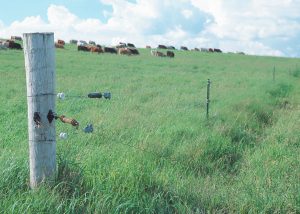
Rotational grazing paddock. Photo: USDA NRCS
Manage grazing by planning for an appropriate grazing-recovery period on your paddocks, keeping in mind that plants need various recovery periods depending on the species, the time of year, and the soil moisture content. Overgrazing (not allowing adequate plant recovery) reduces root mass, photosynthesis, and carbon sequestered into the soil, decreasing soil life. Proper grazing builds soil. This will be covered below in Intake, Density, Yield, and Adaptive Grazing.
Finally, put animal impact to work for you. Livestock provide biology (in the form of microbes shed from their saliva, hair coats, and manure) and nutrient cycling in pastures, contributing to soil organic matter. Their grazing action on forage plants encourages root growth and root exudation of plant sugars that feed soil microorganisms. Pastures that are maintained through grazing and animal impact on the land are characterized by the following:
- Nutrient cycling through feces and urine.
- Timely defoliation and removal of plant material, encouraging regrowth.
- Root death through leaf removal, resulting in underground organic-matter accumulation and nutrient cycling.
- Increased water-holding capacity through accumulation of soil organic matter and soil aggregation.
- Hoof action, which tramples plant biomass, adding carbon to the soil to feed microorganisms and breaking the soil surface, thereby allowing greater germination of seeds and encouraging regeneration of pasture swards.
Managing Forage Resources through Adaptive Grazing
Grazing with multiple paddocks, frequent moves, and long rest periods to provide full plant recovery is a proven method of increasing the resiliency of pastures by building soil organic matter, increasing soil water infiltration, promoting water conservation, and decreasing surface runoff (Teague et al., 2008; Park et al., 2017; Williams, 2015). Coupled with the use of stockpiled pasture and stored forage, the possibility of year-around grazing and forage-finishing of livestock becomes feasible in more parts of the country. In addition, this kind of grazing makes it possible to feed livestock without concentrating wastes in manure pits and lagoons, thereby maintaining nutrients within the pasture ecosystem and preventing them from becoming pollutants in our waterways. When combined with flexible management, this type of grazing has come to be known as adaptive grazing.
Principles of Adaptive Grazing
Allen Williams (2019) speaks of three principles that characterize adaptive grazing. These are as follows:
- The Principle of Compounding – our actions result in a series of compounding and cascading events that are either positive or negative
- The Principle of Diversity – highly diverse and complex pastures create positive compounding effects
- The Principle of Disruption – planned, purposeful disruptions build resilient systems with more vigor and diversity and create positive compounding effects
Adaptive grazing is goal-oriented, focuses on stock density and not stocking rate, and is necessarily flexible. Rotations, grazing-residue heights, rest periods, and grazing seasonality are never the same throughout the year. Adaptive grazing uses frequent movement and adequate pasture rest for plant root-system recovery, and is highly reliant on temporary fencing (Williams, 2016).
Here are some key management considerations:
- Grazing period
- Shorter is better
- Prevent grazing of plant regrowth
- Adequate residual going into plant recovery
- Pasture rest
- Full plant recovery
- Rebuilding carbon and nitrogen stocks
- Paddock size
- Small enough for uniform grazing of forage
- Adjustment of size and numbers as needed
- Paddock number
- More is better
- Having more and smaller paddocks enables shorter grazing periods, full plant recovery, and uniform grazing and nutrient deposition
Adaptive grazing can build soil and pasture-stand health. But to take advantage of these beneficial qualities, a grazier should pay careful attention to pasture rest, recovery, and grass stubble height after grazing. A grazier should be aware of the direct correlation between after-grazing stubble height and pasture health. Grazing is part art and part science, and you should be flexible in moving livestock based on the goals you want to achieve as well as the amount of grass stubble, or residual, that is left behind. Many factors go into when you’ll move to a new paddock, and grass height, both before and after grazing, is one of them.
Grazing Height… How and Why
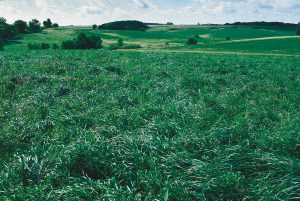 Grasses and legumes on CRP land in southern Iowa cut soil losses by as much as 30 tons an acre a year. |
 Big Bluestem, a warm-season native grass. Photo: Lee Rinehart, NCAT |
 Sorghum-sudangrass, a warm-season annual grass. Photo: Lee Rinehart, NCAT |
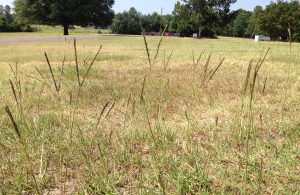 Bahaigrass, a sod-forming warm-season perennial. Photo: Texas A&M AgriLife |
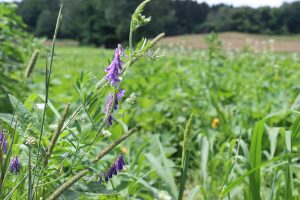 Hairy vetch, a cool-season annual legume. Photo: NCAT |
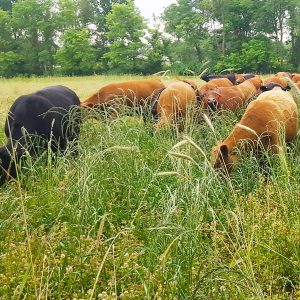
High stock density removes grazing selectivity, thereby utilizing forages more efficiently, and returns large amounts of carbon back to the soil through trampling of uneaten forage. Photo: Understanding Ag, LLC
In general, livestock should be turned onto cool-season pastures (orchardgrass, wheatgrasses, timothy, fescues, legumes, etc.) when the forage is eight to 12 inches tall, and removed when the stubble height is three to four inches tall.
Cool-season grasses have the ability to regrow relatively quickly after grazing, given enough time and soil moisture. Cool-season grasses can regrow by tillering (new shoot growth from the crown) or through sprouting new shoots by way of underground rhizomes, depending on the species.
Native warm-season grasses (big bluestem, switchgrass, Indiangrass) should not be grazed too short, as heavy defoliation can seriously reduce the grass’s ability to persist over time. Warm-season grasses just will not take the kind of defoliation that cool-season grasses can without causing harm to the pasture. It is also advisable to leave six to eight inches of stubble after grazing (during the growing season) for native warm-season grasses. The extra leaf area is needed for the plant to photosynthesize plant sugars and prepare for later winter dormancy. It is essential that these grasses be allowed to regrow from late August until frost, so the grasses can store enough root carbohydrates for winter survival (Smith et al., 2009).
Graze warm-season annual grasses such as sorghum-sudan just before or at heading, when the plants are about two feet tall. Livestock should be removed when these grasses have four to six inches of stubble. Take care when grazing sorghum-sudan and related grasses, as prussic acid poisoning can be a problem if they are grazed too early. See Plant Toxicity for more detailed information.
Grazing can begin when grass is shorter on sod-forming warm-season grasses, such as bermudagrass, bahaigrass, and buffalograss pastures, because these grasses have a more prostrate growth pattern and can generally handle heavier defoliation. Two to three inches of stubble on these grasses is not too short, as long as there is enough moisture to allow regrowth. During drought it is better to leave a longer residual, especially in the spring. Good grazing management in the spring can set you up for better grazing during the hot summer days.
Legumes and Soil Fertility
Legumes like clover, alfalfa, birdsfoot trefoil, sainfoin, and vetch have the ability to convert atmospheric nitrogen to the plant-available form of nitrogen through the symbiotic work of rhizobium bacteria, which occur naturally in a healthy soil. “Nitrogen fixation by legumes can be in the range of 75 to 200 pounds of nitrogen per acre per year in a natural ecosystem” (Jennings, 2016). For well-managed, diverse pastures, supplemental nitrogen fertilization can be eliminated altogether. For pastures under high-density grazing, 70 to 85% of the nitrogen taken in by the animals is returned and cycled back to the soil in the form of feces and urine. Thus, a diverse pasture with at least a 30% legume component can improve forage quality, animal performance, and soil tilth (NRCS, 2005). When managed intensively with heavy stocking and frequent moves, it has the potential to become a stable, closed system.
A mixture of grasses and legumes can be advantageous over a pure grass or legume stand for the following reasons (Johnson et al., 1997):
- Eliminates the need for nitrogen fertilizer because the legume in the mixture will provide nitrogen for grass growth.
- Lengthens the life of the pasture because the grass will remain after the legume stand is reduced. If desired, a legume can be reintroduced by pasture renovation, i.e., frost seeding.
- Reduces the problem of legumes “heaving.” This is the process in which legumes are raised from the soil surface by freeze-thaw action in the late winter and early spring, resulting in plant damage. The grasses hold the legume plants in place better than a pure legume stand can hold itself.
- Reduces soil erosion on steep slopes. Grasses have a more massive root system and are better for soil conservation purposes than pure legume stands.
- Improves livestock performance. A grass-legume mixture can improve animal gain and cattle breeding performance over a pure grass stand, especially when the grass is endophytic-fungus-infected tall fescue. The mixture can also reduce animal performance problems associated with grass tetany and fescue toxicosis.
Ecological Weed Management in Pastures
Agriculture works within a very complex biological system that operates in a particular ecological balance. Each region of the country—indeed each watershed and field—might behave in very different ways because of differences in soil type and depth, indigenous or local plant cover, cropping systems, temperature, and water availability, not to mention field cropping history. Developing a cropping system or perennial pasture that utilizes nature’s own defenses and achieves ecological balance requires thoughtful management.
Nature tends toward the stability that comes with species complexity. Complex systems occupy all available space both above and below ground, and therefore utilize nutrients and water more efficiently. Complex systems are more resilient from year to year, as some species will thrive during wet times, and others will proliferate during drier times. Simple systems such as monoculture pastures, on the other hand, are less resilient and are prone to disease and insect attack due to the absence of diversity. In simple systems, one or two species prevail, and there are fewer niches for beneficial organisms, including soil microorganisms, to occupy. Simple systems also exploit only a single soil layer, and therefore many soil nutrients will remain isolated from the system.
Nature wants to fill all the niches. When we leave a gap, due to overgrazing or poor germination of plants or some other disturbance that leaves bare soil, nature fills that gap with opportunistic, adaptable plants—which we often call “weeds.” In fact, forbs and grasses we typically call weeds are nature’s bandage that helps the landscape recover from disturbance.
Do You Really Have a Weed Problem?
Many plants that are considered pasture weeds are highly palatable and nutritious, especially during the vegetative stage. Take, for instance, dandelion and plantain. Both are numerous in many pastures, and producers can spend thousands of dollars spraying them with herbicides. They are, however, valuable plants that occupy different root zones, and so deliver nutrients from different soil depths. They are also very nutritious and palatable and contain secondary and tertiary compounds that act as natural medicines and dewormers (Villalba et al., 2014). These and many other “weeds” can be a valuable contribution to sustainable pastures. With skilled management, even our so-called “noxious weeds” like knapweed and kochia can be grazed by sheep, goats, or cattle.
Some forbs and grasses are non-native, invasive plants that have the capacity to crowd out other plants. Those types of weeds may need concerted control strategies. In agriculture, we have become very accustomed to taking reactive measures—whether pesticide application or mechanical approaches like cultivation—in order to eliminate unwanted plants and establish a favorable environment for the kinds of plants we want. But if we can look at crop production and pasture as “systems,” and begin to understand how plants and animals and humans interact on a given landscape, weeds will become much less of a problem. For more information see ATTRA’s Sustainable Weed Management for Small and Medium-Scale Farms.
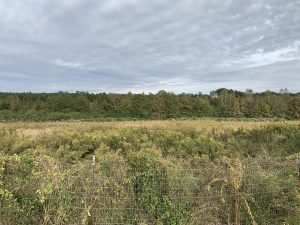
This pasture is a perfect candidate for high-impact, high-density, short-duration grazing. Livestock will pick through and eat many of the plants in this field, including the weeds, and will trample the rest into the soil. A few years of this treatment can turn the pasture into a productive, diverse pasture composed of various grasses, legumes, and forbs. Some ranchers who’ve done this have even observed the return of warm-season native grasses. Photo: Lee Rinehart, NCAT
Techniques for Dealing with Problem Weeds in Pastures
High-density, adaptive grazing diminishes weed concerns by reducing grazing selectivity. As an animal is encouraged to consume all the plants in a given area, no one plant is favored. This gives grass an advantage. Grass, because of the lowered position of its growing point when vegetative, tolerates leaf removal better than broadleaf plants, which often elevate their growing points much earlier in the season. Very intensive systems can even favor grass over legume growth, so pay careful attention to the legume component of intensively grazed paddocks. Reseed annual legumes by frost-seeding, feeding seed to cattle, broadcasting in the fall, or allowing legumes to go to seed to maintain the legume component. See the section Pasture Renovation and Establishment for more information.
If your farm management does not yet allow high-density adaptive grazing, then multispecies grazing can help in controlling weeds. Sheep relish weedy forbs that cattle don’t tend to choose, while goats eagerly consume brush and vines that cattle won’t readily eat. Combining two, or even three, species of livestock on a pasture can result in all the plants being used, so that weeds don’t have an advantage over the grasses. See the Multispecies Grazing section for more information.
Concentrating stock on a patch of problematic weeds and letting them trample the plants is another tactic. If the weeds are toxic, be sure that livestock have had a chance to fill up first on good forages or hay, and then allow the hoof action to damage the plants for a time. Never force animals to consume a toxic plant.
If the terrain allows, another way to keep weeds from taking over is to clip pastures when the plants are flowering and before they have set seed. Flowering takes energy, and mowing at this time will often weaken the plant. Of course, clipping is an expense; if the job can be done by grazing, that saves money and results in gain rather than more cost.
Most of all, know your pastures. Make it a point to understand the soil types and how they change with the aspect and slope of the land. Obtain some reference guides (your Cooperative Extension Service is a great place to find these) that will assist you in identifying the plants on your farm or ranch. The more you know about what your pastures will produce, the better positioned you are to make appropriate management decisions. Read more on this in the section Range and Pasture Monitoring below.
Remember – the principal considerations in managing unwanted pasture plants are these:
- Graze weedy fields with high-density adaptive grazing, reducing grazing selectivity and allowing animals to obtain nutritious forage while trampling the rest into the soil to provide soil carbon
- Encourage forage growth over weed growth through selection of appropriate livestock species and proper timing of grazing
- Ensure adequate soil fertility through nutrient cycling, species diversity, and inclusion of legumes
- Rotate non-erodible fields, especially perennial fields, to break weed cycles. Perennial pastures on non-erodible land can be rotated with cereals, summer annuals, or even vegetables to interrupt weeds, diseases, and problem insects
When pasture stands such as alfalfa get too old, they often begin to decline and allow other plants to take over. Many times, the grass component of the field will increase as alfalfa decreases, but in instances of low fertility or drought, weeds can take advantage of the open niche and become established. Terminating and reseeding the fields is sometimes the best choice in this situation. Some producers refer to this as “farming” the pasture. For some terminated pastures, you might consider planting winter wheat, or oats and winter peas, for a season. These are, themselves, valuable forage crops, and they help to break pest cycles while building soil.
Pasture Renovation and Establishment
When is it appropriate to renovate pastures? Most times, renovation isn’t necessary. Many farmers and ranchers have noticed increased productivity and decreased weed problems merely from adopting adaptive grazing. This is mainly because high livestock density reduces grazing selectivity, and weeds, namely forbs like ragweed, dock, and thistle, which are highly nutritious, become forage instead of a plant that needs to be eradicated.
For fields that have been cropped with annuals for the past several decades, renovation and reseeding might be appropriate, especially if high-yielding dairy cattle or growing lambs are to be grazing them. A short discussion on pasture renovation follows. For more information on field renovation and reseeding, including budgets for pasture establishment on a per-acre basis, see ATTRA’s Pasture, Rangeland, and Adaptive Grazing.
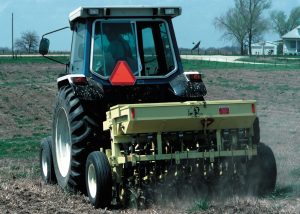
Southern Iowa farmer uses a grass drill to interseed native grasses into a cool-season field of grasses.
Pasture Establishment
Establishing a new pasture is a time-consuming and expensive process. Pay careful attention to proper plant-material selection, soil tilth and seedbed preparation, soil fertility and the addition of compost or manures, green manure plow-down, and amendments with rock powders. Plant materials should be adapted to the native soil pH and water-holding capacity, annual precipitation, temperature, seasonality, and grazing scheme. Renovating worn-out pastures is a good opportunity to incorporate rock phosphate and adjust the soil pH by adding lime according to soil test recommendations.
Proper seedbed preparation is very important for establishing a productive pasture. There are essentially three ways to plant pasture grasses
and legumes: planting into a prepared seedbed, no-till planting into the stubble of a prior crop, and interseeding into an existing stand.
Seed-to-soil contact is extremely important when planting by any method. The seed must remain in contact with moist soil for the first month after germination, or the seedling will wither. There are various methods for achieving seed-to-soil contact while planting. Drilling with a grass drill is the most effective, as it allows for better control of seed placement. Packer wheels that follow the drill firm the seedbed and ensure seed-to-soil contact. Broadcasting seed can be effective for some species, especially if the soil is packed after planting. Pulling a roller or dragging a harrow behind a tractor or four-wheeler is an effective way to increase the germination of broadcast plantings, especially for ryegrass and clover seeds. Other grass seeds, such as timothy, orchardgrass, and most warm-season native grasses, do not establish well by broadcasting and should be drilled. Be careful not to plant too deep, or the seeds might not germinate. Follow local Cooperative Extension recommendations on seeding rate and depth.
Another method of planting new pastures is frost seeding. Frost seeding works well in areas that experience a freeze-thaw pattern in the spring before green-up. Broadcast seeds after snowmelt and allow the natural freeze-thaw action that occurs each day to work the seed into the ground. If the timing is right, this can be an effective way to achieve seed-to-soil contact and incorporate legumes into a grass pasture. For the humid areas of the south or drier areas of the west, fall-seeding of legumes is more appropriate, so that they can get established during the winter rainy season.
For more detail on planting new pastures, see the section on Plant Species and Options for Extending the Grazing Season below.
Intake, Density, Yield, and Adaptive Grazing
There are several factors that go into the grazing equation to determine how well we manage livestock on pasture. In this section, we will discuss each of these in turn and then bring them all together to calculate the size and number of paddocks needed to graze a herd of livestock sustainably. These factors are as follows:
- Intake
- Density
- Yield
- Grazing and recovery periods
- Full recovery (when grasses are ready to graze again)
- Residual (forage left on the paddock after grazing)
- Paddock size and number
Forage intake is directly related to the density of the pasture sward. Ruminants can take only a limited number of bites per minute while grazing, and cattle in particular will only graze for about eight hours per day. It is important, then, to ensure that each bite taken by the grazing animal is the largest bite she can get. For example, cattle graze by wrapping their tongues around and ripping up forage. Large bites of forage are therefore ensured by maintaining dense pastures and allowing taller grazing (see grazing height recommendations listed earlier).
Dense pastures are pastures with actively growing and tillering forage plants. Tillering occurs in grasses that are grazed or mowed while vegetative, resulting in the activation of basal growing points and the initiation and growth of new stems and leaves. Tillering results in a plant covering more basal area, therefore helping to make a pasture denser.
The length of the grazing period (time in a paddock) also has a direct effect on pasture intake. An animal’s intake decreases the longer she remains in a given paddock. This happens due to: (1) the effect of plant disappearance (as plants are grazed) and subsequent searching by the animal for the next bite; and (2) the decrease in crude protein content that begins roughly two days after the animals have been turned in to a paddock, because they have selected the most nutritious plants first. Jim Gerrish (2004) has shown that as an animal remains in a paddock, intake and live weight gains decrease. It is for this reason that most producers move high-producing livestock to new paddocks frequently.
Livestock eat their favorite things first; later, they are left with plants that are not as palatable or plants that have been walked or laid on, and defecated on. This is a strong argument for small paddocks and frequent moves. – Linda Coffey, sheep producer and ATTRA Agriculture Specialist
Give consideration to forage quality and the species of livestock grazing the pasture. The higher the forage quality (vegetative, growing grass, and legumes), the greater the intake. Understanding how much an animal will eat each day can assist producers in estimating forage demand. Refer to Table 1 for information on animal intake by species.
| ;”>Species | Intake (% of body weight) per day |
|---|---|
| Mature cattle | 2.5 to 3.5% |
| Sheep | 3.5 to 4% |
| Goats | 4.5 to 5% |
Determining Forage Yield
Cool-season grass yields can range from four to six and a half tons per acre, and warm-season pastures typically yield from two and a half to four tons per acre, depending on water availability and temperature. In addition, pastures with grasses and legumes grown together typically yield 10 to 15% more forage than monoculture pastures. Producers should determine their pasture productivity, as this will provide a baseline of information with which to make management decisions, such as stocking density on paddocks.
Forage yield can be determined with: (1) a pasture ruler; (2) a rising plate meter; or (3) estimates from historic hay yields. A pasture ruler is just that – a ruler calibrated in inches, placed on end at ground level, with forage height measured in inches. A rising plate meter measures density as well as height. A 20×20-inch plate weighing 2.6 pounds is dropped on a rule at waist height. For this measure in Iowa and Missouri, each inch of forage height equals 263 pounds per acre of dry matter. This has been verified by numerous clip-and-weigh field studies. This measure should be calibrated for local conditions using the clip-and-weigh method to obtain accuracy.
When estimating forage yield per acre with a ruler, measure the height of the forage and multiply the height by the pounds of forage per inch (as depicted in Table 1). For dense, productive pastures, use the highest value in the range. For pastures with low productivity or bare spots, use the lowest value in the range.
A good rough estimate is 300 pounds of dry matter per acre per inch on a ruler. This measure is likely to have 50 to 80% accuracy, depending on whether you have calibrated your measurement procedure. Jim Gerrish’s values range from 150 pounds per acre, per inch in a fair stand to 600 pounds per acre, per inch in an excellent stand, as determined by clipping and weighing numerous quadrants and comparing them to sward heights (Gerrish, 2004). The vast differences in the above estimates reflect differences in pasture types. For example, bermudagrass will most likely be different from bromegrass when measuring stand density with a ruler or rising plate meter.
Clip-and-Weigh Method
Construct a 2-square-foot quadrant frame from PVC or copper pipe (17 inches x 17 inches). Randomly throw the frame on the ground and clip all the plants inside the hoop to ground level. Place the clipped forage into a paper sack, and repeat procedure at least nine more times, placing samples in separate paper bags.
- To determine percent dry matter, weigh one sample in grams (453.6 grams per pound, 28.47 grams per ounce), and place in a microwave oven for two minutes on high setting. Weigh the sample in grams and repeat until no change in weight occurs. Place a small dish of water in the oven to prevent oven damage.
- Calculate the dry-matter percentage of the sample. Percent dry matter = dry weight / fresh weight x 100.
- Multiply the percent dry matter by the fresh weights of the remaining samples.
- Average the weights of all samples, and multiply the dry-matter weight in grams by 50 to get pounds per acre.
- Remember to adjust this figure for allowable use. If you wish to use only half the forage in the pasture, and let the rest be trampled into the soil, multiply the result by 0.50 to get pounds per acre for grazing.
Grazing and Recovery Periods
An important part of grazing planning is the amount of time the animals spend grazing a specific paddock or pasture, and this is known as the grazing period. The important thing to consider in determining the grazing period is the time it takes for a plant to begin to regrow after being grazed. Plants begin to regrow about two to four days after defoliation. A plant that is grazed after it begins to regrow will quickly use its available energy to try to keep up with continued defoliation. Overgrazing is the result of grazing periods that are too long.
If given a choice, livestock will eat the highest-quality, most palatable plants in a pasture. These tend to be the youngest, most succulent plants in the field. A producer must make sure that these plants are protected and have the ability to regrow for the next grazing period. Letting these plants rest after grazing is known as the recovery period.
| Forage species | Dry matter (pounds/acre/inch) |
|
|---|---|---|
| Average | Range | |
| Alfalfa and grass mixes | 225 | 75-400 |
| Arrowleaf clover | 200 | 100-300 |
| Bermudagrass | 260 | 150-500 |
| Caucasian bluestem | 180 | 75-350 |
| Crimson clover | 200 | 100-300 |
| Kentucky bluegrass | 160 | 100-175 |
| Native warm-season grasses | 100 | 50-250 |
| Orchardgrass | 180 | 75-300 |
| Orchardgrass + clover | 200 | 100-300 |
| Red clover | 220 | 100-300 |
| Annual ryegrass | 250 | 75-400 |
| Oats, wheat, rye | 150 | 75-250 |
| Tall fescue | 210 | 100-350 |
| Tall fescue + clover | 190 | 80-325 |
If you wait until the grass has fully recovered, its roots will have become well developed and the plants can handle defoliation again. Grazing intensity can be managed by keeping the grazing period as short as possible. Split a pasture into paddocks with electrical wire or electrical tape, and stock each paddock heavily for a short amount of time. By doing this, you are forcing the animals to eat all that’s there, including weedy plants they might otherwise not eat, and trample the rest into the soil to feed soil microorganisms. It’s important to leave several inches of grass to allow adequate leaf area for subsequent regrowth.
| Cool weather | Hot weather | |
|---|---|---|
| Species | (Days) | |
| Cool-season grasses | 14 | 35-50 |
| Warm-season grasses | 35-40 | 21 |
| Legumes | 21-28 | 21-28 |
| Source: Blanchet et al., 2003 | ||
Depending on the species, you will need to leave from two to eight inches of plant stubble when livestock are moved off the paddock. An 11-paddock grazing scheme that allows animals to graze each pasture for three days will give each paddock 30 days of rest (these figures are for planning purposes, and it is recommended to move according to forage height rather than by the number of days on pasture).
Grazing should be planned based on the plant-recovery period you need, depending on the forage species and the season. For example, in the spring, cool-season grasses are growing quickly in cool temperatures with adequate moisture and need about 14 days to recover from grazing. In the summer, as the temperature warms up and moisture lessens, the recovery period for cool-season grasses increases to at least 35 days. Adjusting your recovery periods based on moisture and regrowth throughout the season and over the course of several years will ensure pastures remain productive and resilient.
Warm-season grasses like bermudagrass and bahaigrass begin their period of growth when the soil temperature is above 60°F, and they thrive on atmospheric temperatures above 75°F. Given adequate moisture, they can be productive all summer and decline in the fall when temperatures reach 40°F. Recovery periods for warm-season grasses during the grazing season are based more on water availability than on temperature.

Fully recovered plant, using basal leaf method. Photo: Dave Scott, NCAT
Grass Recovery
You can easily determine when your plants are fully recovered by using the basal-leaf method. This works well for cool-season grasses. The basal-leaf method involves looking at the leaves growing from the bottom of the plant. When three to five new leaves have grown and the bottom leaf is brown at least one inch from the tip, the grass has pretty much fully recovered from the preceding grazing event. At this point, nutrients from the basal part of the plant have filled the top-most leaves. Stem elongation may occur at this time, and some seed heads may be present, depending on the season.
Residual
Most producers have heard of the saying “take half, leave half.” If this principle is followed, there will be enough residual organic matter left on the soil surface after grazing to keep the soil food web that supports all production running at a sustainable level. If you’re grazing too short, you are badly hurting recovery time and reducing the amount of residue left on the paddock. Residual carbon feeds soil microorganisms, protects the soil from moisture loss, maintains leaf area for photosynthesis, and encourages soil aggregation, which is the basis for healthy, productive soil.
“Take half, leave half ” is a common adage used by graziers to describe the allowable use of forage on a pasture. Leaving half the forage is important for maintaining stand health and preventing root decline through excessive defoliation. It has become a grazing principle as practitioners have realized that when more than half the forage in a pasture is grazed, the roots begin to decline at a rapid rate. At 50% forage utilization, 2 to 4% of root growth stops. But if you take another 10% of the forage, root decline approaches 50%. By the time you get to 80% forage utilization, you essentially have 100% root-growth stoppage (Dietz, 2006).
Residual is a crucial factor in regenerative grazing and is just as important as the forage that is consumed by livestock. The amount of residual is controlled through recovery period, grazing period, and percent forage utilization.
Calculating Paddock Size and Number
Two questions that will immediately come up for someone contemplating adaptive grazing are these: (1) What size should my paddocks be?; and (2) How many paddocks should I have? In order to best describe how to calculate stock density, let’s try an example:
Assumptions:
- Herd size: 50 cows, average weight 1,100 pounds
- Animal daily dry matter intake: 3% of body weight (you could adjust this to 2.5% for dry cows, or 3.5% for cow-calf pairs)
- Paddock rest/recovery period: 40 days (this is likely to change throughout the grazing season)
- Forage height and density at the time animals are turned into paddock: 10 inches tall, excellent stand density of orchardgrass-clover (300 pounds per acre-inch, based on Table 2 above), giving us 3,000 pounds per acre dry matter (10×300)
Grazier’s Math Simplified
Paddock size = herd daily dry matter forage intake ÷ forage dry matter available in pounds per acre
Number of paddocks = (Rest period ÷ grazing period) + 1
The best and easiest method is to consider the total live weight of the herd or flock and not the number of animals you are grazing. Simply calculate the total weight of all animals and get a good estimate of forage yield in your paddocks. The total weight of all animals in the herd in our example is 55,000 pounds. Assuming a daily dry matter intake requirement of 3% of the animal’s body weight, our daily herd dry matter intake requirement is 1,650 pounds (55,000×0.03).
We know that we have 3,000 pounds of forage based on the assumptions listed above, so we subtract half of that to account for the animals eating only half and leaving the rest. This gives us 1,500 pounds of dry matter forage per acre available for grazing. The rest will be trampled in for soil building, maintaining water-holding capacity, buffering soil temperature, and fertility.
Now, we match up the animal intake requirement to the forage available for grazing by dividing the herd’s daily dry matter intake requirement by the forage yield available for grazing. When we divide 1,650 (herd requirement) by 1,500 (forage available for grazing) we get 1.1, or a little more than an acre. What this means is that 1.1 acre will provide the forage dry matter requirement for a herd of cows weighing 55,000 pounds for one day, while leaving enough plant material behind for photosynthesis and feeding the soil biology.
If you want to increase the impact on the pasture (trampling, hoof action, manure, etc.) you can cut that down to half an acre for a half day, which will double the stock density and provide 110,000 pounds of animal liveweight per acre. If you need to reduce the density, simply make the paddock a bit bigger.
To calculate the number of paddocks needed, it’s a matter of dividing the rest period in days by the number of days in the grazing period. If we assume a rest period of 40 days and a 1-day grazing period, we get 41 paddocks [(40 ÷ 1) + 1]. The “+ 1” is added in to the calculation to account for the paddock the animals are on at the beginning of the grazing rotation.
So, for our hypothetical herd of 50 cows weighing a total of 55,000 pounds, 41 paddocks of 1.1 acres each would be a good starting point for the grazing season. The paddocks need not all be initially laid out and constructed. It might be better to make the paddocks as you go, using electrified polywire and fiberglass posts to section off each new paddock. You can adjust (or adapt) based on your observation of how the animals are performing in the paddocks and how the forage recovers after each grazing event. But you do know that you’ll likely need around 45 acres for this herd for the grazing rotation.
The figures and interpretations in the preceding example are highly variable, and your situation will likely be different from this or any other grazing plan. This example is intended to familiarize producers with the basics of calculating stocking density with high-density adaptive grazing.

Multispecies grazing. Photo: Linda Coffey, NCAT
Multispecies Grazing
Multispecies grazing refers to the practice of utilizing different livestock species for different purposes:
- diversify farm income
- utilize pastures of different ecological types on the farm
- manipulate the plant community to meet the production goals of the farm
- interrupt parasite life cycles
John Walker, a range ecologist who studies multispecies grazing, wrote, “The presence of multiple species of large herbivores is the typical condition of grassland and savanna ecosystems” (1994). Multispecies grazing takes full advantage of biological diversity and works best when many forage species make up the pasture composition. When the pasture plant community is more diverse, multispecies grazing tends to improve composition and utilization.
A well-managed farm with abundant diversity is generally healthier, has fewer weed problems, and achieves a higher net income. Some of the positive attributes of grazing multiple species are:
- Increase in carrying capacity
- Ecological resiliency and better pasture health
- Vegetation management and weed control
- Parasite control
- Enterprise diversification and more stable income
- Predator control
Key Considerations for Implementing Multispecies Grazing
Fencing: Your fencing should serve multiple purposes, notably for livestock protection and grazing management. Fences should be appropriate for all species utilized on the farm.
Working Facilities and Shelter: Think about the welfare and behavioral tendencies of the animals, ease of movement, and efficient and safe operation by handlers.
Mineral Supplementation: Grazing different species together can cause some logistical problems and require producers to think about new ways of accommodating the nutritional needs of different animals. For example, cattle mineral should not be fed to sheep due to sheep’s lower tolerance of copper. Goats may safely consume cattle mineral, however.
Using Sheep for Vegetation Management
Sheep have been effectively utilized on western native ranges to control invasive species such as spotted knapweed, leafy spurge, and yellow starthistle. Cattle that are grazing in conventional rotations often remain on western ranges for weeks at a time during the summer, and are moved when a set stubble height of key grass species like bluebunch wheatgrass or rough fescue is attained. When cattle, being primarily grass-eaters, remain in a pasture for long periods of time, they tend to exhibit grazing selectivity and choose vegetative grasses and young forbs over knapweed and other noxious weeds.
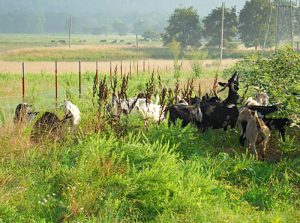
Goats eating weeds. Photo: NCAT
Ranchers who have allowed a band of 800 or more sheep to graze for several days before or immediately after the cattle have seen significant knapweed usage by the sheep, with moderate grass utilization. Applying pressure with diversified livestock to knapweed, other forbs, and grasses in equal amounts will increase range biodiversity significantly over time.
Sheep can be used as an alternative enterprise by taking value from wool, lambs, or by contract grazing on other parcels to control noxious weeds. Goats have a similar utility in areas with shrub infestation, and have been successfully used to control kudzu, English ivy, scotchbroom, Chinese tallowtree, juniper, and mesquite in many parts of the country. Small ruminants can also add value to a farm by providing meat and milk products to growing ethnic groups that seek these traditional foods.
Using small ruminants on cattle operations will necessitate a change in farm and ranch infrastructure. Fencing, lambing sheds, and secure paddocks in areas with predators (wolf, coyote, or bear country) are often necessary, but costs can add up and drain profitability. Other methods of maintaining small ruminants on ranches are:
- Employing a competent herder who will ensure the sheep or goats graze the necessary places
- Running them with guard dogs, donkeys, or llamas as a predator deterrent
For an in-depth discussion of the aforementioned principles of multispecies grazing, see the ATTRA publication Multispecies Grazing: A Primer on Diversity.
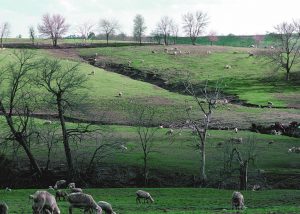
Overgrazing reduces forage productivity, decreases species diversity, reduces soil carbon inputs, slows nutrient cycling, and destroys soil structure. It opens niches for unwanted plants and increases water runoff, erosion, and nutrient loss. Photo: USDA NRCS
Overgrazing
Overgrazing occurs when the grazing pressure exceeds the carrying capacity of the pasture. This condition is not really a function of how many animals are on a pasture, but of how long they remain there. Time is the most important factor in grazing management. Continuous grazing allows livestock to selectively graze the most palatable plants over and over. The problem with this isn’t necessarily in the selective grazing activity, but in the fact that the grazed plant does not get time to regrow before it is grazed again. New growth is more palatable and contains more nutrients than older growth, so animals will come back for a second and third bite as long as they are in the pasture, resulting in the most palatable forages being grazed out.
Prevent overgrazing by dividing pastures into enough paddocks to ensure that all plants have ample time to re-grow after grazing, as described in the Intake, Density, Yield, and Adaptive Grazing section above. In addition, high stock density encourages animals to graze the pasture more uniformly than if the pasture was lightly stocked. In this situation, the “weedy” species are being grazed at the same intensity as the “good” species.
Plant Species and Options for Extending the Grazing Season
There may be times when perennial pasture just isn’t enough. You also may want to extend the grazing season beyond the summer to reduce stored feed needs and save money. For these situations, it’s possible to add annual forages or save summer pasture for winter grazing. This section will discuss some of the annual forage species that work well in northern and southern climates, and it ends with a brief overview of stockpiling forage for winter grazing.
Species used to extend the grazing season include cool-season annual grasses such as ryegrass and cereal grains; forage brassicas like kale, rape, and turnips; warm-season annual grasses such as sorghum-sudan hybrids, pearl millet, and corn; and legumes like Austrian winter pea (cool-season) and forage soybeans (warm-season).
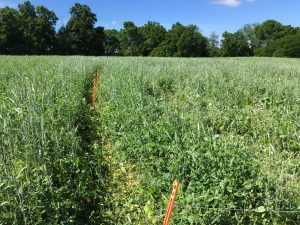
Diverse cool-season annual pasture. Photo: Lee Rinehart, NCAT
Cool-Season Annuals in Warm-Season Perennial Pastures
Annual ryegrass and cereal grains (oats, wheat, and rye) can be overseeded into warm-season pastures in the fall. These pastures will be ready to graze in December to January in the Deep South, and early to mid-spring for parts further north. Ryegrass establishes well when broadcast into perennial sod, but small grains typically establish better if drilled into dormant sod.
In a region where warm-season pastures are common, you can try overseeding annual ryegrass and white clover in September to early October. The following steps will ensure a good stand and adequate forage in the winter:
- Graze the warm-season grasses like bermudagrass closely in the fall, to a height of two inches or less. Broadcast ryegrass and clover at least 30 days before first frost to ensure germination and adequate growth.
- Use a mixture of 20 to 30 pounds per acre of annual ryegrass and five pounds per acre of white clover.
- The broadcast seeder can be pulled behind a tractor, truck, or 4-wheeler. Drag a gate or harrow behind the seeder to allow the seed to fall through the bermudagrass residue and come into contact with the soil. You could lower the seeding rate and drill for better germination, but these species tend to germinate well by broadcasting.
- Begin grazing when the ryegrass is at least five inches tall. Graze lightly in the winter and increase the grazing pressure in the spring according to grass growth. Ryegrass grows well above 40°F and becomes very productive in the spring. Rotational grazing will be necessary to take full advantage of annual ryegrass.
Graze annual ryegrass heavily in the late spring. The ryegrass should not become a competitor when the bermudagrass begins to green up and grow.
White clover will reseed well, and will persist into the early summer in the bermudagrass, to provide supplemental protein to grazing cattle. Ryegrass reseeds itself as well, but will not go to seed if grazed heavily in the spring. Plan on planting ryegrass/white clover each fall for subsequent grazing. Many graziers in the humid south can significantly reduce or even eliminate hay feeding by planting cool-season annuals.
Cool-Season Annuals in Cool-Season Perennial Pastures
Cool-season grasses and legumes are often used as a cover crop in cereal rotations, but they can also be incorporated into perennial pastures with care. Spring grazing of these crops allows ranchers to rest more-sensitive pastures and graze them when the soil is drier and the vegetation better established.
The best way to plant cool-season forages into cool-season perennial pastures is to use a no-till drill. Germination is highly dependent on good seed placement and adequate moisture (Brown, 2014). “I have found what works best, in my environment, is to seed fall-seeded biennials into the sod,” notes Gabe Brown, a crop and livestock farmer in North Dakota. “I prefer cereal rye and hairy vetch, seeded in early September. This tends to get going ahead of perennials in the spring. I prefer to graze this and then immediately seed a warm-season mix directly into the residue. This is grazed in early winter. This year of cover crops tends to jumpstart nutrient cycling and invigorate the grass stand. However, it does not work well with Kentucky Bluegrass or similar invasives” (Brown, 2017).
“On my operation, a mix of winter triticale, hairy vetch, winter pea, sweetclover, and daikon radish works well. We usually get a fall rain that provides good germination. This mix will overwinter well with adequate snow cover. Daikon radish is the exception, but its job is to capture excess nitrogen from the legumes and release it as the radish decomposes in the spring. We graze this mix in the spring.” – Gabe Brown (2017)

Sorghum-sudan. Photo: Lee Rinehart, NCAT
Warm-Season Annuals in Cool-Season Perennial Pastures and Handling the “Summer Slump”
Cool-season perennial grass and legume pastures will often begin to decline in late July and August. Most of their growth occurs when the temperature is 60 to 70°F, so the spring and early summer can see good forage yields and excellent grazing for livestock. But when the “summer slump” arrives, graziers need to have an alternative to keep animals on a high plane of nutrition, and maintain them without expensive feed inputs.
What follows is a list of several things a livestock manager can do to get animals through this downtime in the summer when grazing cool-season grasses.
- Graze closely in the spring, leaving about a 2-inch stubble. Be careful to rotate at the right time so animals do not have time to graze the re-growing shoots before the plant recovers, or you will begin to deplete the root reserves. Close grazing in the spring makes cool-season grasses “tiller,” or send out side shoots that grow into new leaves and more forage later in the season.
- As temperatures increase and plant growth declines, leave a little more residue on cool-season grasses if you can. Move livestock when the grass is three to four inches in height. More leaves remain available to capture sunlight and supply nutrients the plant needs to re-grow.
- Keep up the rotation even when growth slows down. Grazing removes older leaves and allows newer, more nutrient-dense leaves to take their place. Watch your residue height.
- Consider warm-season annual crops to fill in during the summer slump. Millets, sorghum/sudangrass, and several varieties of brassicas (such as turnips) are available that can be spring planted and grazed during the late summer. Warm-season annual grasses are generally more nutritious than warm-season perennials, and can maintain livestock on a high plane of nutrition right through the summer, until the cool-season grasses get back on their feet.

Goats grazing turnips. Photo: Linda Coffey, NCAT
Brassicas
Brassicas can be spring- or summer-planted into corn or other annual crops to provide late-summer or fall forage for livestock. These crops produce high biomass and are well suited to strip-grazing. Forage brassicas can be used in a mix with grasses and legumes for late-season grazing. Rapes and turnips are short-season crops yielding from 7,000 to 8,000 pounds per acre. Kale is a later-maturing crop that can produce as much as 12,000 pounds per acre. Brassicas are very digestible for livestock and can have dry matter digestibility compositions greater than 85% in the vegetative stage. Crude protein is high as well, with tops often greater than 17% crude protein and roots greater than 12% protein. This is fine feed for most classes of livestock, especially in the fall, when nutrient requirements can be low. Brassicas are generally low in fiber; therefore, it is important to watch for problems with rumen acidosis. Provide hay or other forage when grazing pure brassicas, and restrict brassicas to no more than two-thirds of diet to prevent digestive problems.
Brassicas can be interplanted into a warm-season annual crop such as corn, milo, or beans in two ways, an early-season or a late-season planting. No-till works best if you can get in early enough, but if broadcasting, be sure to increase the seeding rate by at least half. For early-season planting, sow brassicas at two to four pounds per acre at last corn cultivation (V7 to V9). This typically occurs at around three to five weeks after emergence. Later plantings are successful if broadcasted into corn at blister stage, or no later than two weeks after silking. Broadcast planting rates should be increased to three to six pounds per acre at the very least.
Turnips and rutabagas will be ready to graze 70 to 90 days after seeding and will hold up well into the winter if good grazing management is employed. Kale will be ready to graze from 120 to 150 days after seeding. Strip grazing is best, as this gives daily control of defoliation and helps to control intake, as well. Turnips can be grazed to the ground without damaging regrowth, but other brassicas should be grazed no lower than about six inches to maintain the stand late into the season.
Warm-Season Annuals in Warm-Season Perennial Pastures
Warm-season annuals like pearl millet, corn, and sorghum-sudan are highly nutritious, provide quality forage, and can also be used to supplement warm-season perennial pastures, especially for growing livestock that benefit from higher-quality forage in the summer. The best way to graze these is to strip-graze a portion of a field each day, using a back-fence or wire, especially if regrowth is expected for subsequent grazing. Careful attention to drought-stressed plants is warranted, as these are susceptible to excessive nitrate and/or prussic acid accumulation and subsequent livestock poisoning. See the section Plant Toxicity for more information on forage-related disorders.
Annual forage crops can be an excellent addition to a farm by extending the grazing season several weeks or even months. However, annual cropping systems often come with environmental costs such as erosion, loss of organic matter, and destruction of soil structure when soils are heavily tilled. Consider no-till or minimum-till and rotating annual crops to different fields each year to minimize environmental impacts such as water or wind erosion.
| Cool-Season Cover Crop Mix (lb/ac) |
Warm-Season Cover Crop Mix (lb/ac) |
||
|---|---|---|---|
| Forage Oats | 30 | Cowpea | 10 |
| Forage Barley | 25 | Soybean | 10 |
| Forage Peas | 40 | Pearl Millet | 2 |
| Hairy Vetch | 5 | Sorgham/Sudan | 10 |
| Kale | 1 | Radish | 1 |
| Plantain | 1 | Turnip | 1 |
| Sunflower | 1 | ||
| Buckwheat | 3 | ||
| Safflower | 2 | ||
| These diverse cover crop mixes occupy all the regions of the soil profile and include deep-rooted plants, shallow-rooted plants, warm-season plants, cool-season plants, grasses, broadleaves, legumes, and brassicas. A mix also provides insurance in case one or more species doesn’t germinate or fail to grow due to drought or pest damage. Forages such as these return carbon to the soil, keep the soil covered, provide resiliency through diversity, and make for excellent grazing. These particular mixes work in the High Plains and may need to be adjusted based on regional differences. “The important thing for a farmer to do is to use a mix that will best address the resource concerns found in that particular field” (Brown, 2019). | |||

Cows moving to fresh pasture, Sieben Live Stock Company, Montana. Photo: Cooper Hibbard
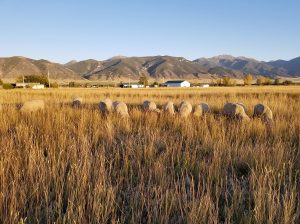
Stockpiling grass for grazing in southwest Montana. Photo: Dave Scott, Montana Highland Lamb
Stockpiling Forages
Stockpiling is defined as letting forage grow during summer and deferring grazing to the fall or winter. This is an effective way of providing winter forage in some areas, and it can reduce the need for harvested forage. If it reduces hay use at all, significant savings can be realized. This system works well for early winter when spring-calving cows are in mid-pregnancy. Stockpiled grazing can be followed with meadow feeding of high-quality hay.
Stockpiling has been shown to work well, given appropriate pasture management and efficient allocation of dormant pasture during the winter. Many grass species will maintain a relatively high nutrient content and palatability for several months after dormancy begins. Two extra months of grazing can significantly reduce the costs associated with producing and feeding hay. In some cases, producers have been able to utilize stockpiled forage and eliminate the need for hay feeding completely. This usually works better in climates where the dormant grass can be preserved longer under adequate snow cover, and/or because of reduced microbial decomposition caused by low temperatures and limited moisture.
Stockpiled forages can either be limit-fed (allowing only so many hours of grazing per day), or strip-grazed with a movable electric wire or tape. Other options for feeding stockpiled forages are to swath them with a hay mower, and then rake them into windrows. Cattle can graze directly off the windrow during the winter by using an electric wire or tape to ration hay on a daily basis. This is similar to strip-grazing, in that the wire is moved each day to expose a predetermined amount of forage for grazing. This method, while still relying on a tractor to cut and windrow the hay, reduces the amount of fuel, materials, and equipment needed for baling and feeding hay by eliminating the baling process altogether. This method works best in drier regions, where weathering is less likely to reduce the nutritional quality and palatability of the hay.
Forage Species for Stockpiling
In the North and West:
Altai Wildrye, OrchardgrassIn the South and East:
Bermudagrass, Orchardgrass
Reed Canarygrass, Timothy, Alfalfa, Tall Fescue, Reed Canarygrass
Regenerative Grazing on Rangeland
Using adaptive grazing has shown positive effects on rangeland (Teague et al., 2008; Teague et al., 2013). The key is short-duration paddocks and long rest periods. Cooper Hibbard of Sieben Live Stock Company in Montana grazes 800 to 1,000 cows (without calves) on 6- to 20-acre winter paddocks, moving daily in a 16-inch annual precipitation zone. In the summer, 1,250 cow-calf pairs graze 60- to 400-acre paddocks for two to eight days before they are moved to the next paddock. Hibbard has been able to increase the carrying capacity of their pastures due to grazing management, and having calving dates in May and June aligns calving with forage production and has allowed them to graze their aged cows year-round.
The trick is to take no more than half the available growing forage in a rangeland situation and ensure rest periods are long enough for full recovery. In annual precipitation zones of less than 14 inches, Scott suggests rest periods of one year are not out of the question (Scott, 2019).
Regenerative grazing on dry upland sites necessitates adaptive management and observation. Take a look at the native plants on an upland range site if you have the opportunity. Some, like bluebunch wheatgrass and little bluestem, are large-statured and can handle several bites from an animal in one grazing event. Some, like Sandburg bluegrass, Idaho fescue, and black grama, are smaller, and one bite is all it takes to reduce the plant to stubble. Cattle, especially, tend to graze severely, so don’t get too caught up in how much they take off. Strive for 50% use or less, and allow for regrowth. For some sites on dry ranges, this will mean one grazing event per year. For areas with more moisture, you might be able to return for another grazing event.
Range and Pasture Monitoring
If it rained an inch every week of the grazing season, farmers wouldn’t need to worry about planning. But it doesn’t rain every week. There are dry periods, wet periods, and resulting unpredictable forage growth, and many times farmers are just not producing enough grass for the grazing days needed. Without a tool to mitigate uncertainty, farmers remain reactive in their management.
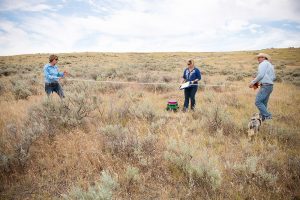
Chelsea and Bryan Phipps (right), landowners in Garfield County, Montana, along with Sue Fitzgerald (left), Garfield County NRCS district conservationist, measure out a transect for rangeland monitoring. Photo: USDA-NRCS
Monitoring provides a baseline of relevant information and orients a farmer to looking at the ground to understand ecological processes. Producers can record, plan, and use land-improvement practices based on ecological factors to start making pre-planned decisions. The management decision-making process therefore makes farmers into strategic grazing managers instead of reactionary grazing observers.
A monitoring plan is an essential part of a grazing plan. It is a feedback mechanism that will provide information on what’s going on in your pastures, both from climate and ecological factors, as well as from management decisions. A good monitoring system will alert you to failure before it is too late and record successful grazing strategies.
A good monitoring system will allow you to check how your management decisions are working on the ground. It will allow you to determine, for instance, if a particular grazing plan is having the desired effect over time. A monitoring plan will often involve a few important evaluation criteria, such as plant species composition, percent cover, soil aggregation, and water infiltration rate. By comparing these measurements over time, you can start to see trends, and by comparing them to your grazing plan, you can alter and adjust where you need to in order to arrive at your goals.
Recordkeeping is a very important part of pasture monitoring. In addition to recording the aforementioned physical measurements, keep track of when livestock enter and leave a pasture, what (if any) materials or chemicals are used, revegetation or weed-control treatments, and observations on animal health while in the pasture. This information will be extremely useful in refining your grazing plans.
There are many tools available to help you plan and monitor your grazing. What is most important, though, is that the tool be simple and accessible, so that it is easy to use. And if all your information is available in one place, so much the better.
One method that meets these criteria is a grazing chart. One of the most notable is the grazing chart developed by Troy Bishopp, a New York grazing specialist and contract grazier, which offers graziers the ability to track grazing each day (On Pasture, 2019). There is plenty of room on the chart to record production information, weather and precipitation, recovery periods, or anything else that you think is important to track.
To be effective, monitoring must be consistent, practical, and simple. ATTRA has a simple checklist to help producers monitor their grazing lands.
For detailed information on using Troy Bishopp’s grazing chart, see the On Pasture website, which has numerous articles on how to use the charts.
The grazing chart is a tool that can be customized based on your own goals, constraints, and needs for documentation and recordkeeping. You can choose the events, indicators, and management tasks that are most important to you, such as animal weights, breeding, calving or lambing, grazing days, paddock recovery period, rainfall or snowfall, temperature, forage yield, forage residual after grazing, and monitoring data, just to name a few. Pasture monitoring is particularly important because the information obtained will inform grazing planning for subsequent grazing seasons, thus giving you a feedback loop to validate and update your grazing calculations.
Managing for Drought
Drought is a natural ecosystem process. The concept of an “average” or “normal” precipitation or temperature is a fabrication that humans use to try to understand complex systems and attempt to predict behaviors and outcomes. Whether in a humid zone or an arid environment, a producer will experience relative wet and dry years. Dealing with the dry years is a real challenge to livestock operations that rely on water to grow the plants and recharge the aquifers and streams that feed the animals. Having a drought plan is a very important component of a well-thought-out farm or ranch management plan.
A drought-management option that deserves serious consideration is for a producer to maintain livestock numbers at 75% of carrying capacity for “normal” years, and utilize the extra forage in wet years for high-value animals such as stockers (Ruechel, 2006). In dry years, the pastures will be better able to accommodate current livestock numbers. Another option is to slow down paddock rotations during dry years, thereby allowing more paddock or pasture rest time. This option can be effective, especially when the herd is split between different pastures to minimize the impact on drought-stressed plants.
If you must de-stock during drought, consider which animals should be the first to go. Do you have low-producing females? Do you have older calves that can be sold as stockers? Whichever you do, be sure not to de-stock too late. Pasture that is overstocked and drought-stressed is hard to repair, whereas a cow herd can be bought when rains return.
Plant Toxicity
Graziers must pay careful attention to the negative health effects that certain plants can cause in livestock. Plant toxicosis occurs either through the ingestion of: (1) poisonous plants; or (2) forage plants that contain toxic substances due to environmental or physiological conditions. Plant poisoning, as can occur from water hemlock, nightshade, or astragalus, can be significantly reduced by proper grazing management. These poisonous plants contain resins, alkaloids, and/or organic acids that render them unpalatable. If the pasture contains enough good forage, there is little reason for the animals to select bad-tasting plants. Contact your local Cooperative Extension office for information on poisonous plants in your area.
The following section illustrates some of the more common and economically important environmentally or physiologically caused disorders.
Your Local Cooperative Extension office
Contact your local Cooperative Extension office for information on poisonous plants, forage nitrate testing, and locally adapted forages. The USDA maintains an online database of local Cooperative Extension offices. You will also find the phone number for your Cooperative Extension office in the county government section of your telephone directory.
Bloat
Livestock can bloat when they consume vegetative legume pastures, such as clovers and alfalfa. Bloat is a condition manifested by the distention of the rumen, noticed as a severe protrusion on the animal’s left side caused by fermentation gasses that are not able to escape. Legumes are high in protein, and the more immature the plant, the higher the concentration of proteins it contains. These proteins are very rapidly digestible and produce gas very quickly; faster than the animal can expel. Control is accomplished in four ways:
- Ensuring the legume component is less than 50% of the pasture stand composition;
- Feeding one-third of the daily dry matter requirement as long-stem grass hay before grazing lush pastures that contain greater than 50% alfalfa or clovers;
- Planting a non-bloating legume like Cicer milkvetch, sainfoin, or birdsfoot trefoil; and/or
- Feeding an anti-foaming agent. Anti-foaming agents are usually fats, oils, or synthetic surfactants.
Note: Organic producers should make sure that they do not feed prohibited materials. Any treatments they use or plan to use must be listed in their Organic System Plans and approved by organic certifiers before use.
Grass Tetany
Grass tetany is caused by low blood levels of magnesium (Mg). When succulent cool-season grasses are grazed early in the spring, the condition can occur quickly (have rapid onset). Symptoms include lack of coordination, staggering, and eventually death. Grass tetany is prevented through the following strategies:
- Delaying spring grazing;
- Feeding a legume hay with spring grass pastures (legumes are higher in Mg than grasses);
- Providing a mineral supplement; and/or
- Grazing early spring pastures with less-tetany-prone animal such as steers, heifers, and cows with older calves. Pre- and post-partum cows are most susceptible to grass tetany.
Prussic Acid Poisoning
Prussic acid, or hydrocyanic acid, is a toxin that occurs in annual grasses such as Johnsongrass, sorghum, and sorghum-sudan hybrids. When these grasses are stressed due to drought or frost, prussic acid levels accumulate and, if the plant is grazed by livestock, will cause salivation, labored breathing, and muscle spasms. Death can occur very quickly after consumption. Prussic acid does not persist as do nitrates. Forage that has been ensiled or harvested as hay and dried to less than 20% moisture is safe for consumption. Prussic acid poisoning can be prevented using these methods:
- Testing for prussic acid if conditions are right
- Avoiding grazing for a week after the end of a drought. Young plant tissue after a drought-ending rain will be high in prussic acid
- Avoiding grazing for a week after a killing frost
- Using pearl millet as a warm-season annual forage (pearl millet does not produce prussic acid)
- Avoiding turning hungry livestock into a suspect pasture
- Allowing forages to grow tall (18 to 24 inches) before grazing (Flack, 2016). Tender regrowth may be high in prussic acid.
Testing for prussic acid requires timely delivery to the lab, as cyanide levels decline after the plant is harvested. Refrigerate—but do not freeze—samples if you cannot get them to the lab right away. If mailing samples to the lab, mail them on a Monday to reduce the chances that the sample sits in a post office over the weekend.
Contact your local Cooperative Extension office for information on forage prussic acid testing.
Nitrate Poisoning
All plants contain nitrates, which are the precursor to plant proteins. Excess nitrates will accumulate in the lower stems of some plants when they are stressed from a drought, heavy rain, or long period of cloudy weather. In effect, nitrate accumulation occurs when photosynthesis slows down. During this time, the plant may not be metabolizing nitrates, but it will still be taking nitrates from the soil. The result is a “backlog” of poisonous nitrate in the plant stems. Concentrations of 1.5% or more in plant tissue can be toxic to livestock, while concentrations of less than 0.25% are considered safe. Excess nitrates can be deadly to livestock, and the most commonly affected plants are annual grasses such as the cereal grains (oats, wheat, and barley), warm-season annual grasses (sorghum, pearl millet, and corn), and broadleaf plants like pigweed, thistles, goldenrod, and lambsquarters. In contrast to prussic acid, nitrate toxicity in forage does not decrease with time (thus, grass harvested as hay can still contain dangerous nitrate levels months later). Nitrate poisoning can be prevented through the following actions:
- Testing of suspect plant tissue prior to feeding;
- Delaying harvest or grazing of suspect forages for several days to a week after the end of a drought;
- Beginning harvest or grazing of suspected forages in the afternoon, after the plants have had several hours of sunlight (this helps the plants metabolize nitrates);
- Chopping forage and diluting with clean hay; and
- Minimizing nitrogen fertilization.
Contact your local Cooperative Extension office for information on forage nitrate testing.
Fescue Toxicosis
Another important condition to consider in the South and Midwest is fescue toxicosis, which is caused by fungi growing symbiotically with the plant. Three distinct ailments can occur when livestock consume infected tall fescue. Fescue foot results in fever, loss of weight, rough hair coat, and loss of hooves or tail switch. Bovine fat necrosis is a syndrome characterized by hard fat deposits in the abdominal cavity. Summer slump is evidenced by fever, reduced weight gain, intolerance to heat, nervousness, and reduced conception. Fescue toxicosis can be reduced by using these strategies:
- Seeding legumes to dilute fescue intake;
- Early close grazing of fescue to reduce seed development;
- Grazing stockpiled fescue only after a hard frost;
- Restricting nitrogen fertilization to the summer, when warm-season grasses are actively growing; and
- Replanting with endophyte-free seed or another grass species, such as orchardgrass.
Final Thoughts

Ewes making their way from night camp to the day’s grazing in a dryland meadow. Photo: Dave Scott, Montana Highland Lamb
When a livestock producer relies on pasture or rangeland to supply the protein and energy requirements of livestock, it benefits the farm, the watershed, and the community in significant ways. Pasture-based animal agriculture promotes environmental stewardship and community development owing to the following management practices:
- Limiting the use of off-farm inputs such as diesel, fertilizer, and purchased feed;
- Minimizing—or, better, eliminating—the use of toxic substances such as herbicides and soluble fertilizers;
- Conserving and building soil carbon through limited tillage and use of perennial pastures, which store carbon in the soil while building soil organic matter;
- Conserving water and energy resources through monitoring and appropriate
technologies, such as irrigation monitoring, solar and wind technologies, and biofuel development and use where applicable; - Adjusting to local environments through the selection of proper plant and animal genetics, such as locally adapted native pasture plants and low-maintenance animals;
- Managing for biological diversity through grazing management, especially through planned grazing that favors grass growth and full recovery of the pasture,
- Carefully managing forages and livestock to prevent soil erosion and improve water quality;
- Marketing food to local communities, reducing the distance food travels from farm to plate and provisioning the community with better, fresher food;
- Fostering the development of local processing plants to add value to local animal products while providing employment and economic development; and
- Developing a management philosophy that values health in people, animals, plants, and soil.
This publication does not attempt to cover every topic related to regenerative pasture and grazing management. Refer to the resources listed and reach out to us at ATTRA if there are still gaps. ATTRA specialists can research specific topics and write detailed responses to your questions. And, if interest is shown on a topic, we may write follow-up pieces. To let us know what your needs are Ask an Ag Expert. Best wishes for your success!
References
Ball, Donald M., Carl S. Hoveland, and Garry D. Lacefield. 2015. Southern Forages. 5th ed. International Plant Nutrition Institute, Peachtree Corners, GA.
Blanchet, K., H. Moechnig, and J. DeJong-Hughes. 2003. Grazing Systems Planning Guide. University of Minnesota Extension Service, St. Paul, MN.
Brown, Gabe. 2014. Seeding cover crops into perennial sod. Graze Magazine.
Brown, Gabe. 2017. Personal communication.
Brown, Gabe. 2019. Personal communication.
Dietz, Harland E. 2006. Grass: The Stockman’s Crop; How to Harvest More of It. Sunshine Unlimited, Inc.
Flack, Sarah. 2016. The Art and Science of Grazing: How Grass Farmers Can Create Sustainable Systems for Healthy Animals and Farm Ecosystems. Chelsea Green Publishing, White River Junction, VT.
Gerrish, J. 2004. Management-intensive Grazing: The Grassroots of Grass Farming. Green Park Press, Ridgeland, MS.
Jennings, John. 2016. Value of Nitrogen Fixation From Clovers and Other Legumes. University of Arkansas Cooperative Extension Service.
Johnson, K., C.L. Rhykerd, and J.O. Trott. 1997. Forage Selection and Seeding Guide for Indiana. Agronomy Department, Purdue University, Cooperative Extension Service, West Lafayette, IN.
Mercola, Joseph. 2013. An Interview with Jerry Brunetti: How Biological Farming Can Transform Your Food Supply for the Better. Mercola website.
Missouri Department of Conservation. No date. Native Warm-Season Grass Pastures.
Montana DNRC. 1999. Best Management Practices for Grazing in Montana. Montana Department of Natural Resources, Helena, MT.
NCAT. 2004. Organic Livestock Workbook: A Guide to Sustainable and Allowed Practices. National Center for Appropriate Technology, Butte, MT.
NRCS. 2005. Grazing Guide Sheet # 2, Adding Legumes to Predominantly Grass Pastures. USDA Natural Resources Conservation Service.
On Pasture. 2019. Troy’s Grazing Charts and How To Use Them.
Park, Jong-Yoon, Srinivasulu Ale, W. Richard Teague, and Jaehak Jeong. 2017. Evaluating the ranch and watershed scale impacts of using traditional and adaptive multi-paddock grazing on runoff, sediment and nutrient losses in North Texas, USA. Agriculture, Ecosystems and Environment. Vol. 240. p. 32-44.
Ruechel, J. 2006. Grass-Fed Cattle: How to Produce and Market Natural Beef. Storey Publishing, North Adams, MA.
Scott, Dave, NCAT Agricultural Specialist. 2019. Personal Communication.
Smith, S. Ray, Garry Lacefield, and Tom Keene. 2009. Native Warm-Season Perennial Grasses for Forage in Kentucky. University of Kentucky Cooperative Extension Service.
Society for Range Management. 1998. Glossary of terms used in range management. 4th ed. Edited by the Glossary Update Task Group.
Teague, Richard, Fred Provenza, Brien Norton, Tim Steffens, Matthew Barnes, Mort Kothmann, and Roy Roath. 2008. Chapter 1, Benefits of Multi-paddock Grazing Management on Rangelands: Limitations of Experimental Grazing Research and Knowledge Gaps, in Grasslands: Ecology, Management and Restoration. Hans G. Schroder, Editor. Nova Science Publishers, Inc.
Teague, Richard, Fred Provenza, Urs Kreuter, Tim Steffens, and Matt Barnes. 2013. Multi-paddock grazing on rangelands: Why the perceptual dichotomy between research results and rancher experience? Journal of Environmental Management. Vol. 128. p. 699-717.
USDA. 1997. Conservation Practice Standard, Prescribed Grazing, Code 528A. USDA Natural Resources Conservation Service.
Villalba, Juan J., James Miller, Eugene D. Ungar, Serge Y. Landau, and John Glendinning. 2014. Ruminant self-medication against gastrointestinal nematodes: evidence, mechanism, and origins. Parasite. Vol. 21. p. 31.
Walker, John. 1994. Multispecies grazing: The ecological advantage. Sheep Research Journal, Special Issue.
Williams, Allen. No date. Adaptive High Stock Density Grazing. Pasture Project, The Wallace Center.
Williams, Allen. 2015. Recent Data Supports Soil Health Benefits of Adaptive High Stock Density Grazing. Grassfed Exchange.
Williams, Allen. 2016. Adaptive Grazing and Relationship to Soil Health (presentation).
Williams, Allen. 2019. Personal Communication.
Further Resources
Pasture and Grazing Publications and Tools from ATTRA
ATTRA Grazing Planning Manual and Workbook
Building Healthy Pasture Soil
Managed Grazing Tutorial
Grazier’s One-Stop Resource Packet
Grazing Calculator: Extended Cow-Calf Pair
Intensive Grazing: One Farm’s Set Up (video series)
Irrigated Pastures: Setting Up an Intensive Grazing System That Works
Multispecies Grazing: A Primer on Diversity
Nutrient Cycling in Pastures
Paddock Design, Fencing, Water Systems, and Livestock Movement Strategies for Multi-Paddock Grazing
Why Intensive Grazing on Irrigated Pastures?
Online Resources
Aggregate Stability
Soil Quality for Environmental Health. NRCS East National Technology Support Center.
A concise description of why we need soil aggregates and how we can build them up. Discusses the importance of soil aggregate stability as an indicator of organic matter content, biological activity, and nutrient cycling in soil; problems caused by poor management; and how to improve the aggregate stability.
Electric Fencing for Serious Graziers
2005. By USDA Natural Resources Conservation Service, Columbia, MO.
Topics include selecting an energizer, grounding, selecting wire, temporary fencing, gates and braces, tools, safety, and troubleshooting.
Evaluating the ranch and watershed scale impacts of using traditional and adaptive multi-paddock grazing on runoff, sediment and nutrient losses in North Texas, USA
2017. By Jong-Yoon Park, Srinivasulu Ale, W.R. Teague, and Jaehak Jeong. Agriculture Ecosystems & Environment. Vol. 240. p. 32-44.
Adaptive MP grazing was found to be an effective conservation practice on grazing lands for enhancing water conservation and protecting water quality.
Extending Grazing and Reducing Stored Feed Needs
2008. By Don Ball, Ed Ballard, Mark Kennedy, Garry Lacefield, and Dan Undersander. Grazing Lands Conservation Initiative, Bryan, TX.
Outlines strategies that can be used in many areas to extend grazing and reduce stored feed needs, thus increasing profit.
Grazing Cover Crops: How-To Guide
2018. By Allen Williams. The Wallace Center Pasture Project.
Introduction for farmers and ranchers interested in learning more about the benefits and practices of grazing cover crops. It covers establishment, management, and adaptive grazing of cover crops.
Foraging Behavior: Managing to Survive in a World of Change; Behavioral Principles for Human, Animal, Vegetation, and Ecosystem Management
2003. By Fred Provenza, PhD. Utah State Universty.
This booklet will provide you with a new understanding of why animals eat what they eat, why they forage where they forage, and why they act the way they act. The principles in this book, once understood, can make a difference in how you manage your land and animals or how you advise others to do so. These principles, when applied, can make a difference in animal performance, natural resource conditions, and farm and ranch profitability.
Intermountain Planting Guide
No date. By Kevin Jensen, Howard Horton, Ron Reed, Ralph Whitesides, and USDA-ARS-FRRL. USDA-ARS-Forage and Range Research Lab, Logan, Utah and Utah State University Extension.
A guide to establishing and managing pasture seeding for irrigated pasture, rangeland, and dry pasturelands. Includes seeding tables and descriptions of plant species.
Multi-paddock grazing on rangelands: Why the perceptual dichotomy between research results and rancher experience?
2013. By Richard Teague, Fred Provenza, Urs Kreuter, Tim Steffens, and Matt Barnes. Journal of Environmental Management. Vol. 128. p. 699-717.
Provides a framework for rangeland management decisions that support the productivity and resiliency of rangelands and then identifies why different perceptions exist among rangeland managers who have effectively used multi-paddock grazing systems and research scientists who have studied them.
NRCS Soil Quality Test Kit
USDA Natural Resources Conservation Service.
An expanded list of soil health tests you can perform on the farm. Describes procedures for 12 on-farm tests, including: soil respiration test, infiltration test, bulk density test, electrical conductivity test, pH test, soil nitrate test, aggregate stability test, slake test, earthworm test, and water-quality tests. Includes an interpretive section for each test, data recording sheets, and a section on how to build your own kit.
Quivira Coalition educates land managers and the public on soil, biodiversity, and resilience on western working landscapes through education, innovation, and collaboration. Offers technical guides on ecological resource management, including range management, grazing, road construction, monitoring, and managing resources at the urban-rural interface.
Rangeland Health and Planned Grazing Field Guide
2009. By Kirk Gadzia and Nathan Sayre. Earth Works Institute, Quivira Coalition, and the Rio Puerco Management Committee.
This field guide is an introduction to grazing management designed to help landowners, contractors, and agency personnel make better grassland-management decisions. Grazing can have a deleterious effect on water quality if it is not managed well. Improved management decisions will increase vegetative cover, control erosion, and improve animal production.
Rangelands West
Western Rangelands Partnership, Agriculture Network Information Center, University of Arizona.
Web-based educational tools and information to assist resource managers with improving rangelands and maintaining sustainability.
Runoff reduced, water retention increased by multi-paddock grazing
2017. By Kay Ledbetter. AgriLife Today. Texas A&M University.
Adaptive multi-paddock grazing has been found to be an effective conservation practice on grazing lands for enhancing water conservation and protecting water quality, according to a Texas A&M AgriLife Research study at Vernon.
Video with ranchers Allen Williams, Gabe Brown, and Neil Dennis on how they are regenerating their soils while making their animals healthier and their operations more profitable.
Soil for Water
National Center for Appropriate Technology, Southwest Region.
A project of the National Center for Appropriate Technology in partnership with Holistic Management International, designed to create a critical mass of landowners who are applying regenerative agricultural practices that improve soil health and the water cycle. The website includes information on Soil for Water trials, landowner enrollment information, and resources including podcasts, articles, videos, management guides, ATTRA soil resources, and monitoring protocols.
Soil Health Education and Resource Guide, 5th Edition.
No date. By Green Cover Seed.
Concise and simple summary of the concepts of regenerative agriculture featuring articles by Gabe Brown, Ray Archuleta, Allen Williams, and more. Covers the principles of soil health, cover cropping, and grazing.
Stockmanship and Handling Cattle on the Range
2004. By Steve Cote, Natural Resources Conservation Service.
A guide book on how to use the Bud Williams method of low-stress cattle handling and herding to move livestock on extensive open rangeland. Contains many diagrams that show you how to turn, move, and sort large and small herds of cattle without fences.
UnderstandingAg, LLC
Ray Archuleta, Gabe Brown, Shane New, and Allen Williams
A regenerative agricultural consulting company that educates the agricultural community in the principles and practices needed to restore, repair, rebuild, regenerate farming and ranching ecosystems. Website includes resources and information on Soil Health Academy Schools.
Understanding Forage Quality
2001. By Don Ball, Mike Collins, Garry Lacefield, Neal Martin, David Mertens, Ken Olson, Dan Putnam, Dr. Dan Undersander, and Mike Wolf. American Farm Bureau Federation, Park Ridge, IL.
Information about forage quality and forage testing that can be used to increase animal performance and producer profits.
Watering Systems for Serious Graziers
2006. By USDA Natural Resources Conservation Service, Columbia, MO.
Topics include livestock water needs, water sources, delivery systems, tanks, protection of watering areas, tank location, pipe installation, and spring-water development.
Pasture, Rangeland, and Adaptive Grazing
By Lee Rinehart, NCAT Agriculture Specialist
Published 2006, Updated March 2020
© NCAT
IP306
Slot 301
This publication is produced by the National Center for Appropriate Technology through the ATTRA Sustainable Agriculture program, under a cooperative agreement with USDA Rural Development. ATTRA.NCAT.ORG.
Related ATTRA Resources
- ATTRA Grazing Planning Manual and Workbook
- Building Healthy Pasture Soils
- Grazier’s Calculator: Forage Production and Grazing Demand
- Intensive Grazing: One Farm’s Set Up (video series)
- Irrigated Pastures: Setting Up an Intensive Grazing System That Works
- Managed Grazing Tutorial
- Managing Soils for Water: How Five Principles of Soil Health Support Water Infiltration and Storage
- Multispecies Grazing: A Primer on Diversity
- Nutrient Cycling in Pastures
- Paddock Design, Fencing, Water Systems, and Livestock Movement Strategies for Multi-Paddock Grazing
- Why Intensive Grazing on Irrigated Pastures?

